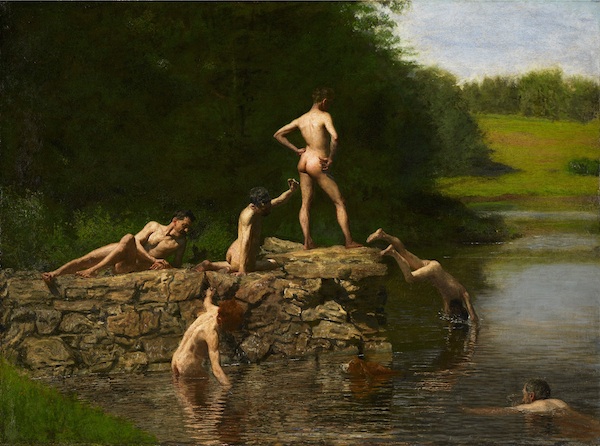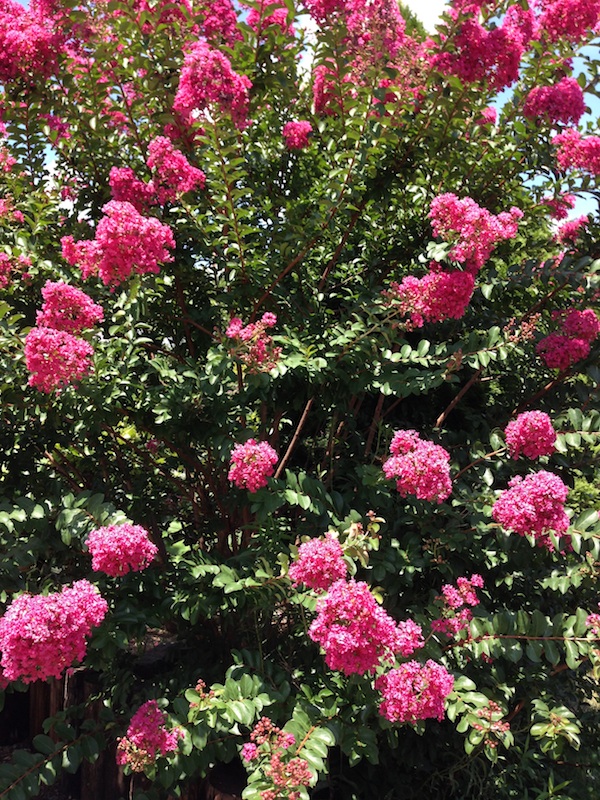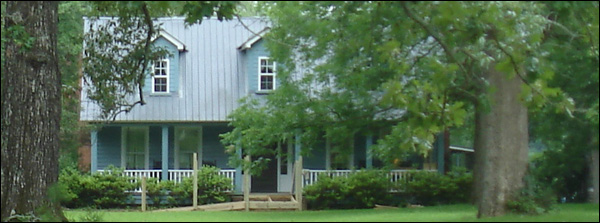Summers Remembered, Seasons Foreseen
“Summer’s heat brings changes. The exuberant flush of wild growth and mad flowering, the unstoppable compulsion to reproduce that defines callow springtime, gives way to a slower-paced savoring of the gifts of the new season. Warmth is plentiful—indeed, sometimes too much so; clouds of insects perform winged Eros’s role, intermediaries in the reproductive dance of the garden. The furious pace of spring seems excessive now, and the gardener and his garden may each seek a bit of shade to relish the present moment.”—William A. Balk, Jr.
Epicurus’ Porch
By William A. Balk, Jr.

 ELKO South Carolina—(Weekly Hubris)—7/14/2014—With accelerating age and the passage of seasons, I seem to have developed an increasing appreciation for the pleasures of those three seasons other than summer.
ELKO South Carolina—(Weekly Hubris)—7/14/2014—With accelerating age and the passage of seasons, I seem to have developed an increasing appreciation for the pleasures of those three seasons other than summer.
Nevertheless, I retain an almost boyish sense of awe and joy as summer arrives, an unmistakable urge to wander bare-shouldered and bare-footed in blazing sun and through splashing sprinklers. The cold black waters of the Edisto River, the briny taste of rolling Atlantic waves—summer’s temptations, for a boy, retain their untarnished appeal, if only in golden memory.
Now, however, my arthritic wandering would be bare-pated and hardly sure-footed; bare shoulders would risk inflaming melanoma. A cold beer and a briny plate of local shrimp are more likely to draw my attentions than surf and sand. Summer’s pleasures are not diminished but, rather, altered.
Gardens here in the South Carolina coastal plain are very like my aging self during the summer. While much of the world rejoices at summer’s garden bounty, here we find that the exuberant display of spring and the abundance of our delicious, late-spring produce begin to diminish as the intense heat and frequent rains end much of the show and usher disease and destruction into the garden.
Tomatoes, that mainstay of the home garden, cannot “set fruit” in our summer heat; if the tomato plants have resisted disease thus far, they will doubtless succumb soon, and we will see the last of our local tomatoes until the fall season. Potatoes, too, have a short time yet for harvest. Cool-season peas are long gone, of course, along with carrots and beets and most greens.
There are, however, warm-season “peas,” Vigna unguiculata, which will be yielding their crop as summer begins its wane—the best and rarest being the tiny Lady Peas or Rice Peas cherished by cooks in the 18th and 19th centuries, but mostly lost to modern cooks; melons, okra, and sweet corn are all warm-season crops, wonderful summer foods now emerging from our gardens.
The ornamental gardener faces a similar shift in the garden’s focus. In our climate, many of the perennials which have filled the garden with color and scent for several months are nearing exhaustion from their efforts. If we shear them hard, many will be able to re-grow in the long season of heat to flower again in the fall. The bulbous plants which have finished blooming should not, of course, be shorn. It is the summer’s green growth which allows the bulb to rebuild its stored strength, enabling it to bloom again the next year.
Some bulbs are at their peak now. The many Hemerocallis, the daylilies, are dramatic in their enthusiastic bloom; their colors range from soft pinks and corals, to melon yellow and lemon yellow and gold, to reds, rich oranges, purples—and even white. I daily scout the scapes for spent blooms to remove, preferring that the plant’s energy continue to be directed to more flowering and not to making seeds. (I will admit to allowing a few seed pods fully to ripen, and to planting the seeds in hope of discovering a remarkable, marketable new variety. None so far has fulfilled my hopes.)
There are the striking stems of the Formosa lily (Lilium formosanum), sometimes eight feet tall, with multiple large white “Easter” lily trumpets at the tops. They set seed by the thousands and are quite hardy in our climate, resulting in the spectacle of dozens of lilies popping up in unusual places. They also appear in the lawn and in garden beds where they are unwanted; these get mown or pulled just like any other weed. I swear each year I will remove the candelabra seed heads before they can spread their seeds but, somehow, the resolution to do so disappears as the seeds ripen unmolested and spread.
My friends in the North seem invariably to hold in cherished memory the look and scent of lilacs. So far, no lilacs have been developed to survive our short winters and torrid summers, as well as the ill-timed wet months that we enjoy in the Deep South. There are rumors of a new variety which shows potential for use here, but I’m more than a little skeptical; besides, it is reputedly a yellow lilac with no mention of scent . . . . What would be the point of growing it?
I have none of my friends’ yearning for the lilac: I have the crepe myrtle to enjoy. Lagerstroemia was introduced into the southern landscape from China at the end of the 18th century, when André Michaux brought them to his nursery in Charleston. This crepe myrtle, Lagerstroemia indica, is the old-fashioned species found everywhere throughout the South, often covered much of the summer with panicles of pink, white, lavender, or red blooms. The indicas grow reasonably well in our climate, despite a vulnerability to fungal disease in humid summers.
More recently, breeding programs at the US National Arboretum introduced Lagerstroemia fauriei into the gene pool. This is the Japanese crepe myrtle, and attractive traits such as resistance to fungal disease, increased cold tolerance, and dramatic, peeling bark have been brought to the characteristics available now in crepe myrtle.
The new indica x fauriei hybrids are indeed spectacular, but they seem to lack the brilliant fall color of the old-fashioned indicas. The hybrids’ resistance to fungal disease is welcome, but on the old-fashioned crepe myrtles growing in the landscape at our old farmstead, we find that the old trees shed their sooty leaves in mid-summer, quickly re-grow fresh green growth, and develop brilliant red-yellow-orange-purple foliage in the fall. They seem diminished not at all from the annual fungus-initiated defoliation.

There seems to be something about the crepe myrtle which drives gardeners and landscapers to commit gross molestations of any crepe myrtle within sight. I know of decades-old plants, prominently planted for dramatic effect, which annually are coppiced—cut down to the base of the plant—to force vigorous new stems to shoot up each spring six to eight feet tall. Huge single panicles of shocking pink blooms form on the tip of each new stem, compelling the stems to bend outward under the weight of the flowers. Municipal tree-care specialists seem especially drawn to whacking off perfectly well-grown crepe myrtles at chest height, leaving five-foot bare trunks from which spring the aforementioned forced new growth of long slender stems tipped with giant lollipops. They are emphatic, to be sure, but look more like monumental vases of artificial flowers than the beautiful flowering trees they really should be.
The crepe myrtle in its natural state is handsome in both form and flower. Whether trained as a single-trunk specimen or encouraged to grow with several trunks from the base, the form is open and upright. The branching is light but plentiful, somewhat horizontal in growth, while the main trunk(s) continues a vertical push. Instead of a massive football-sized panicle of flowers at the end of a stem, the natural flowering form produces smaller panicles at the tip of every branch—hundreds and hundreds of brilliant blooms covering the tree. It is a beautiful and awe-inspiring sight. I cannot imagine sacrificing the brilliance of this show and the graceful texture and silhouette of the natural crepe myrtle for the gaudy manipulations of radical pruning. Some, apparently, disagree.
Summer’s heat brings changes. The exuberant flush of wild growth and mad flowering, the unstoppable compulsion to reproduce that defines callow springtime, gives way to a slower-paced savoring of the gifts of the new season. Warmth is plentiful—indeed, sometimes too much so; clouds of insects perform winged Eros’s role, intermediaries in the reproductive dance of the garden. The furious pace of spring seems excessive now, and the gardener and his garden may each seek a bit of shade to relish the present moment.
It is fitting to take that moment in the shade. Ahead is yet another season, one with its own accelerating pace to complete tasks undone, to ripen fruits still small and green in the summer. And after that, still another. The gardener will one day add the last of his seasons to his life, but the inexorable progress, Act to Act, will continue in the garden. The garden, too, will one day see its ordered existence progress toward entropy. For now, a moment in the cooling shade is welcome respite indeed.

5 Comments
Anita Sullivan
William, I am so grateful for this detailed description of gardens in your climate! Here in the Northwest we have to wait until July for the full flowering. Your tomatoes are done about the time ours start to ripen! I hope you have enough bees — we are way down in our usual numbers out here, they’ve been killed off by pesticides.
Will Balk
Anita, thank you! The peculiarities and challenges of our climate leave me jealous of the gardening climate of your Northwest…but these same peculiarities make our gardening such a great pleasure. I am always checking out the degree of green of another pasture.
Isn’t it amazing – almost every gardener I know eventually gets around to asking about bees. Here in the lower coastal plain of South Carolina, we have indeed watched the decline of the honeybee population. Lately, though, I’ve been giving more notice to all the other insect species which perform pollination duties – there are so many! My despair at the fate of the bee is sharing space in my observations with new hope for these other species.
By the way, I am always looking forward to your next contribution to Weekly Hubris…I can’t wait!
Allen Pitts
Will….
Are you the same person I knew at USC living behind the Lutheran Student Center?
If so….how the hell are you? :-)
Will Balk
Hey, Allen! How’d you find me here at Weekly Hubris? If you’re on Facebook, send me a friend request…I looked, but couldn’t find you there. It would be great to touch base again.
Sandra Baggette
What at pleasure to read your wonderful description of summertime here in our gardens. My whole soul is begging for lady peas with fresh tomatoes and corn and maybe alittle cornbread. Thanks for sharing